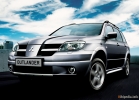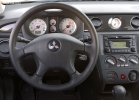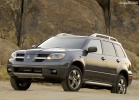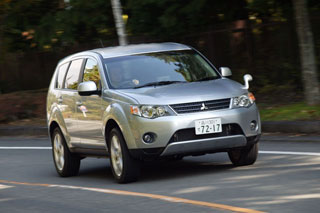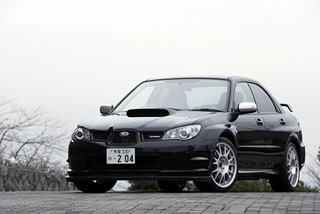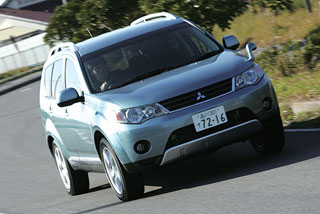Test drive Mitsubishi Outlander (Airtrek) 2003 - 2007 SUV
Party of drums
Mitsubishi Outlander has a fairly expressive face in order to have an impact on those who dared to take the strip in front of him in the rear -view mirror. Now he also had other significant arguments.Still, Mitsubishi can please the not too rich enthusiasts of dynamics. Here, say, Lancer Evolution is a relatively inexpensive alternative to all sorts of expensive sports delights. And I must say, a very meaningful alternative, especially when their favorite travel routes run not only through German autobahns, but also on the Middle-Russian intercity roads. And how in corners it goes!
But when on winter until early April, it is difficult to disagree with the eternally uncleaned consequences of yesterday's snowfall that the national city car should have increased cross -country ability. Only now, the average owner of a not too expensive SUV had to be content with a 22.4-liter engine of 140160 horses. And there was nothing special to answer the presumptuous owners of the dear.
Now it’s a completely different matter. For in addition to the shock appearance of Mitsubishi Outlander received a stroke temperament, the source of which is the famous 4G63 motor with turbocharged. True, the force level here is lower than that of Lancer Evo (202 hp against 265), but this is enough for the relatively light Outlander to develop 220 km/h and gain a hundred in less than 8 seconds. Ideology is the same: an impressive dynamics for meaningful money.
However, do not think that Outlander Turbo relates to the usual Outlander in the same way as Evo relates to the usual Lancer. There are no reinforced rally pendants, and the all -wheel drive system is quite traditional: a symmetrical interdose differential, partially blocked by a viscous coupling, and a differential of high friction from the back. And in general, try to abstract from advertising: do not think that Turbo is a certain special-super-exclusive version, which has just been made for European fans of fast driving. In the Japanese market, many models we know are found in such modifications that in Europe and Americas did not even dream of. The Outlander, called in the homeland, is no exception. There, the TURBO version has been sold for a long time and it happens even 240-horsepower!
However, in Japan and gasoline quality is much better, so we will not envy much: we can assume that in our conditions our Outlander will last longer.
If we talk about appearance and interior, then Outlander Turbo does not differ from the usual one, except that it is sold only in the richest configuration. And it remains to regret that other seats are not offered for the dynamic version: standard leather arranges you do not have too conveniently relative to the steering wheel, they are high. I would like to lower the pillow lower, and the adjustment of the steering column seems generally meaningless: the steering wheel never leaves the highest position. Somehow not very sporty.
Speaking of sports. If you want to demonstrate what Turbo has a stormy temperament, try so that during acceleration, the engine speed does not fall below 3500 min-1. No, he behaves quite confidently to the smaller ones, but deals with the reaction to pressing the accelerator pedal. And so, up to 3000 min-1 is an ordinary 2-liter engine. Nevertheless, above 3000, this is just a song both in the literal and figurative sense. In a figurative because a powerful jerk and rapid acceleration will give you real pleasure. Moreover, the gearbox, unlike less powerful counterparts, does not rest here and allows you to switch at an intense pace. And in the direct because, like all Mitsubishi, Outlander Turbo after 3500 min-1 is rather loud, though his hoarse voice can hardly be called pleasant.
This is not to say that Outlander Turbo reacts sharply to the actions of the steering wheel, but still it is quite fast and most importantly accurate in reactions. On smooth asphalt is stable, but we would not have recorded it on cruise for long trips. And not at all because after the irregularities it sometimes has to be corrected. The worse is that with standard seventeen -inch wheels and appropriate tires, you count the potholes of distant from the perfection of the intercity track literally with the stomach. We tried to switch to 16 inches and considered it a sound solution for a long trip: having lost almost nothing in controllability, Outlander gained decent comfort and excellent stability, allowing us to easily brush 700 kilometers without rest and stops.
As for extreme exercises, be careful. It seems tilted, this Mustang is actually a norovist and requires good preparation. On slippery coating, it is not very willing to turn into a turn, trying on occasion to slip out. And if you still have enough width of the road so as not to fly out, you can try to transfer it into a subscription of gas: it will rest, but then, maybe, it will agree. And do not yawn here.
Fast riding is economically not too appropriate. Especially on EVO and its closest motor relatives consuming only the highest -octane gasoline and in fair amounts. No exception is Outlander. We will not categorically argue that it is always voracious: if you slowly, without sharp accelerations, roll 2000 min-1 along a suburban road, you can even be surprised at the moderation of its requests. But if your mood is not moderately combat, then be prepared. Moreover, the problem may not even become that the 98th is noticeably more expensive than the 95th, but that it occurs noticeably less often. And if you were caught up to the point that you have to pull it before the gas station, how to fear the whistle of the waking turbine (it appears about 3000 min-1): this is a signal that a real hungry wolf woke up in the lamb!
+ Impressive dynamics, worthy of handling.
The delay in the reaction to pressing the accelerator pedal, not the best smoothness.
Technical characteristics Mitsubishi Outlander 2.0
Body station wagon
The number of places 5
Equipped mass, kg 1595
Dimensions, mm:
- length 4545
- Width 1750
- Height 1670
Base, mm 2625
Maximum speed, km/h 220
Acceleration time to 100 km/h, from 7.7
Control consumption of fuel, l/100 km:
- City cycle 14.1
- Zagorodny 7.6
- Mixed 10
Fuel tank capacity, l 60
Engine:
- type of gasoline, four -cylinder with turbocharged
- working volume, cm3 1997
- Power, L.S. at MIN-1 202/5500
- Torque, N.M at min--1 303/3500
Mechanical transmission, 5-speed, all-wheel drive
Tire size 215/55R17
Wheel suspension:
- Front Mcpherson
- The rear is multi -link
Brakes:
- front disk, ventilated
- rear disc
Spear control of the rack type, with gur
Text: Dmitry Filonov
Source: Magazine 5 wheel [05/2005]
Video Crash tests Mitsubishi Outlander (Airtrek) 2003 - 2007
Test drives Mitsubishi Outlander (Airtrek) 2003 - 2007
Mitsubishi Outlander (Airtrek) 2003 - 2007
Mitsubishi Outlander malfunctions: Detailed information| Outlander (Airtrek) 2003 - 2007 | |
|---|---|
| Engine |  |
| Transmission |  |
| Control system and suspension |  |
| Brake system |  |
| Air heating and air conditioning |  |
| Launch and charging system |  |
| Electric components and so on |  |
| Corrosion body stability |  |


